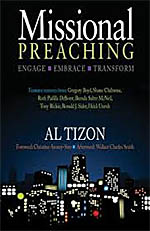Book Review: Missional Preaching: Engage, Embrace, Transform by Al Tizon
Al Tizon, Missional Preaching: Engage, Embrace, Transform
(Valley Forge, PA: Judson Press, 2012). 164 pages. $14.19

Since the inception of the term “missional” in the late 1990s from the Gospel and Culture Network to describe the essence of the triune God as about sending and, derivatively, prescribing the essential character of the Church as about sending disciples of Jesus Christ, multiple misconceptions abound about what is involved in truly being missional. For some, missional was appropriated as a new wineskin with old wine, retaining a still very ecclesiocentric sense of evangelism (“come to my church to hear about Jesus”). For others, missional assumed a noblesse oblige posture towards mission in the U.S. and around the world, where mission teams were sent to do short-term missions in impoverished communities, but without lasting transformative effect on the community, nor on the participants who easily returned back to places of privilege; at its best, these were quick-fix remedies to symptoms of systemic poverty and injustice; at its worst, it was a commodification of people―regarding the foreign “other” as in need of “us” and seeing the “other” as totally bereft of the presence and power of the triune God.
Tizon seeks to recapture the true meaning of missional for a 21st century world. But his volume is not merely an effort to correct the misuse of the term; his volume describes the practical implications of being missional upon the preaching craft, and, by extension, upon the mission and ministry of the Church. In doing so, he begins the book with an excellent summary of mission Dei theology, noting the pioneers in the field: Lesslie Newbigin, Karl Hartenstein, Karl Barth, David Bosch, and Darrell Guder. He then discusses the missional basis of the Bible, which testifies of the missionary nature of the triune God. What we have in the holy Scriptures are accounts of an unfolding narrative of God on the move, moving with and moving upon a covenant community as the comprehensive, reconciling work of God in Christ through the Holy Spirit extends and flourishes. The agenda of the triune God is no less than the transformation of the entirety of creation.
The implications of missional theology upon preaching are immense. Chapters 4 through 10 feature representative sermons to discuss the various homiletical dimensions when missional theology infuses preaching; such preachers as Ruth Padilla DeBorst, Brenda Salter McNeil, Shane Claiborne, and Ron Sider, demonstrate “preaching for enculturation,” “preaching for the alternative community,” “preaching for holistic transformation,” “preaching for justice and reconciliation,” “preaching for whole-life stewardship,” “preaching for shalom: life and peace,” “preaching the scandal of Jesus.” Tizon fleshes out for us what preaching does to a community; preaching doesn’t leave a community content with itself, content with blessing, and content with the status quo. How can it? God is on the move in the world, in communities and neighborhoods, and the Church has been invited to participate.
Missional preaching takes seriously sin in its individual, communal, organizational, societal, and systemic forms, and takes the Good News of Jesus Christ seriously to address those expressions of sin and brokenness. Tizon exegetes the signs of the times well. We are to be anchored to the Gospel in the variety of cultural expressions, nimbly engaging with other faith traditions, working for peace and reconciliation, fighting injustice, alleviating poverty, and all that ails the human condition in mind, body, and spirit.
At the end of the volume is a brief, helpful series of diagnostic questions that we pastors/preachers and teachers can ask ourselves when we prepare to preach and after we have proclaimed the Good News. Are we truly being missional in our preaching? Are we being faithful to the trajectory of God’s calling upon us and the Church―to gather us and to send us, for the life of the world? I commend this volume as a companion to Clayton Schmit’s Sent and Gathered, an excellent liturgical counterpart to Tizon’s volume.


